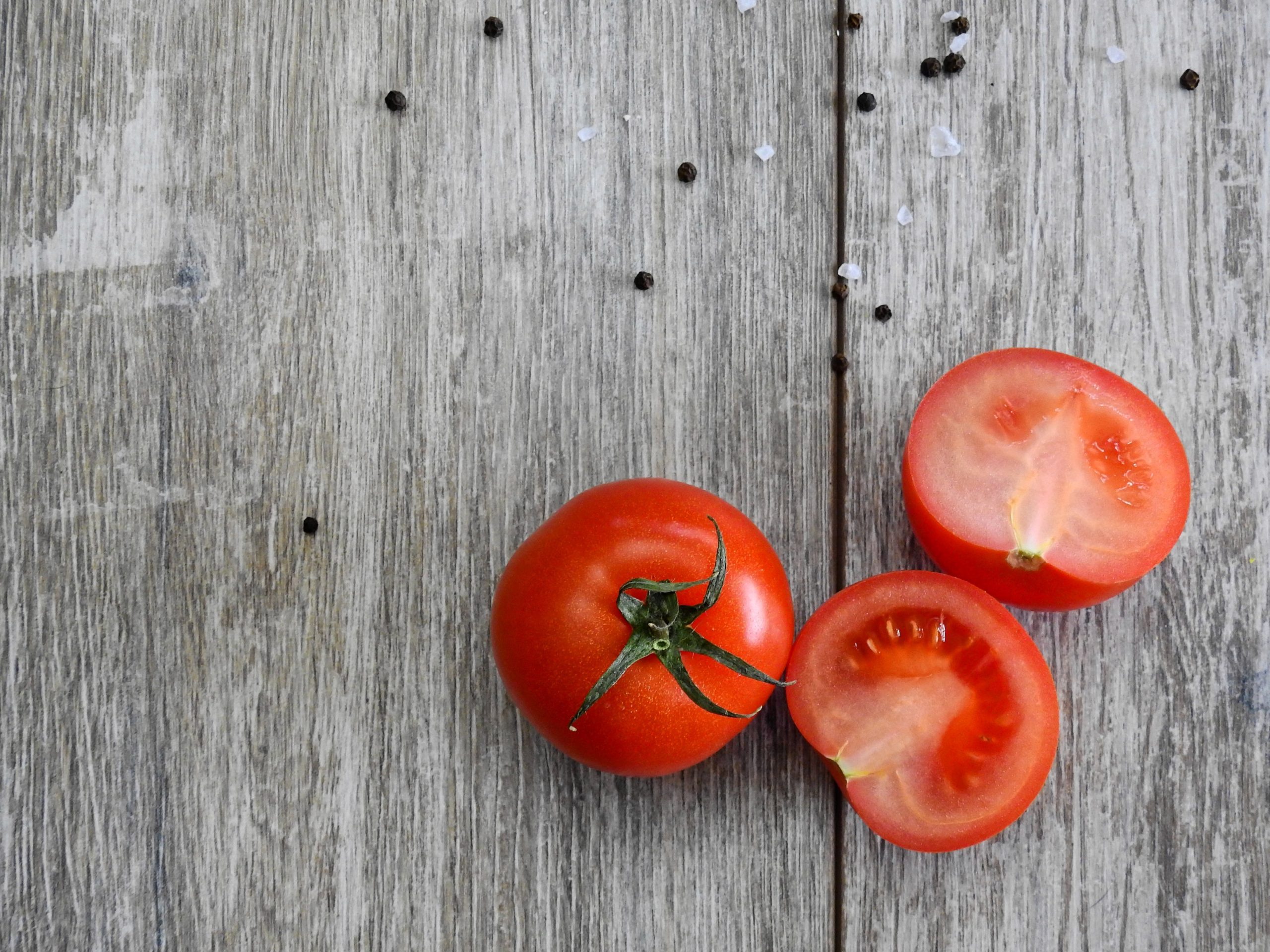
What Is a Tomato?
A tomato is a vibrant and versatile fruit belonging to the Solanaceae family, scientifically named Solanum lycopersicum. While commonly treated as a vegetable in culinary contexts, it is botanically classified as a berry. Native to western South America, tomatoes have become integral to global cuisines.
With a smooth, glossy exterior, tomatoes come in various colors, including red, yellow, orange, and green, depending on the variety. The fleshy interior contains numerous seeds encased in a gel-like substance. Tomatoes offer a balance of sweetness and acidity, with a rich umami flavor.
Beyond their culinary uses in salads, sauces, soups, and sandwiches, tomatoes boast nutritional value. They are rich in vitamins like C and K, antioxidants, and lycopene, linked to potential health benefits. Tomatoes thrive in diverse climates, contributing to their widespread cultivation and popularity in a myriad of dishes worldwide.
Why Do We Eat Tomatoes?
Tomatoes are consumed for various reasons, encompassing their versatile culinary applications, nutritional benefits, and delicious flavor. Here are some reasons why tomatoes are widely enjoyed:
- Versatility in Cooking:
- Tomatoes are incredibly versatile in the kitchen. They can be used in salads, sauces, soups, stews, sandwiches, and numerous other dishes, adding depth, color, and flavor.
- Rich Flavor Profile:
- Tomatoes offer a unique combination of sweetness and acidity, contributing to a rich and savory taste. This distinctive flavor enhances a wide range of savory dishes.
- Nutritional Benefits:
- Tomatoes are a good source of essential nutrients, including vitamins C and K, potassium, and antioxidants. They contribute to overall health and well-being.
- Lycopene Content:
- Tomatoes contain lycopene, a powerful antioxidant associated with potential health benefits, including reducing the risk of certain diseases.
- Hydration:
- Tomatoes have a high water content, contributing to hydration and making them a refreshing addition to meals, especially in salads.
- Diverse Varieties:
- There are numerous tomato varieties, each with unique characteristics. From cherry tomatoes to beefsteak tomatoes, the diverse options cater to different culinary preferences and uses.
- Culinary Foundations:
- Tomatoes are a foundational ingredient in various cuisines around the world. They form the base for many sauces, such as marinara and salsa, and are essential in Mediterranean, Italian, and Mexican dishes.
- Year-Round Availability:
- Tomatoes are cultivated in different climates, allowing for year-round availability. This accessibility contributes to their widespread use in diverse culinary traditions.
Overall, the culinary flexibility, nutritional content, and delightful taste make tomatoes a staple ingredient in kitchens globally. Whether enjoyed fresh, cooked, or processed into sauces and condiments, tomatoes remain a fundamental and cherished component of many cuisines.
When Do We Eat Tomatoes?
Tomatoes are a versatile ingredient enjoyed at various times of the day and incorporated into a wide range of dishes. Here are common occasions and ways people eat tomatoes:
- Fresh Snacking:
- Sliced tomatoes or cherry tomatoes are often enjoyed as a refreshing and healthy snack.
- Breakfast:
- Tomatoes can be included in breakfast dishes such as omelets, scrambled eggs, or on toast.
- Lunch:
- Tomatoes are commonly used in salads, sandwiches, wraps, and as a topping for burgers and tacos.
- Dinner:
- Tomatoes play a central role in numerous dinner dishes, including pasta sauces, stews, curries, grilled or roasted vegetables, and various meat or vegetarian entrees.
- Appetizers:
- Tomatoes are featured in appetizers like bruschetta, caprese salad, and stuffed tomatoes.
- Salsas and Dips:
- Tomatoes are a key ingredient in salsas, guacamole, and other dips, often served as accompaniments or appetizers.
- Condiments:
- Tomato-based condiments like ketchup, tomato sauce, and tomato chutney are used to enhance the flavor of a wide range of dishes.
- Soups:
- Tomatoes are a common ingredient in soups, such as tomato soup and gazpacho, enjoyed as a starter or a light meal.
- Grilled or Roasted:
- Grilled or roasted tomatoes can be served as a side dish or used as a topping for various main courses.
- Preserves and Sauces:
- Tomatoes are used to make preserves, sauces, and marinades, providing flavor to dishes throughout the year.
The diverse uses of tomatoes in culinary applications make them suitable for breakfast, lunch, dinner, and everything in between. Whether enjoyed fresh, cooked, or processed, tomatoes are a versatile and indispensable ingredient in many cuisines.
Ingredients of Tomatoes
Tomatoes are a simple yet flavorful fruit commonly used in a variety of culinary applications. The main components of tomatoes include:
- Water:
- Tomatoes have a high water content, contributing to their juiciness and hydrating properties.
- Carbohydrates:
- Tomatoes contain natural sugars, mainly fructose and glucose, providing a sweet taste.
- Dietary Fiber:
- Tomatoes are a good source of dietary fiber, including both soluble and insoluble fibers. Fiber supports digestive health and promotes a feeling of fullness.
- Vitamins:
- Tomatoes are rich in essential vitamins, particularly vitamin C, which is an antioxidant that supports the immune system. They also contain vitamin K, vitamin A, and various B-vitamins.
- Minerals:
- Tomatoes provide minerals such as potassium, which is important for maintaining proper fluid balance in the body and supporting heart health.
- Antioxidants:
- Tomatoes contain various antioxidants, including lycopene, beta-carotene, and quercetin. Lycopene, in particular, is associated with potential health benefits.
- Acids:
- Tomatoes have a slightly acidic taste due to the presence of citric acid and malic acid.
- Phytochemicals:
- Tomatoes contain phytochemicals, including flavonoids and carotenoids, which are naturally occurring compounds with potential health-promoting properties.
It’s important to note that the specific nutrient content can vary slightly depending on the variety and ripeness of the tomato. The skin and seeds of tomatoes also contain additional nutrients and fiber. Tomatoes are not only delicious but also offer a range of nutrients, making them a healthy addition to a balanced diet.
Types of Tomatoes
There are numerous varieties of tomatoes, each with its own unique flavor, size, and culinary uses. Here are some common types of tomatoes:
- Roma Tomatoes (Plum Tomatoes):
- Oval-shaped with fewer seeds, Romas are known for their meaty texture, making them ideal for sauces, pastes, and canning.
- Cherry Tomatoes:
- Small, round, and typically very sweet, cherry tomatoes come in various colors, including red, yellow, and orange. They are popular in salads and as a snack.
- Grape Tomatoes:
- Similar to cherry tomatoes but more oblong in shape, grape tomatoes have a sweet taste and are often used in salads or as a garnish.
- Beefsteak Tomatoes:
- Large, juicy, and often irregularly shaped, beefsteak tomatoes are commonly used for slicing in sandwiches, burgers, and salads due to their size and robust flavor.
- Heirloom Tomatoes:
- These tomatoes come in various colors, shapes, and sizes. Heirlooms are prized for their unique flavors and are often used in salads or eaten fresh.
- Campari Tomatoes:
- Small and round like cherry tomatoes, Campari tomatoes have a sweet and tangy flavor. They are often sold on the vine and used in salads.
- San Marzano Tomatoes:
- With a distinct elongated shape, San Marzano tomatoes are prized for their sweet flavor and low acidity. They are commonly used in Italian dishes and sauces.
- Green Tomatoes:
- Tomatoes that are harvested before they fully ripen and turn red. They have a tangy flavor and are often used in fried green tomato dishes.
- Yellow Tomatoes:
- Similar in flavor to red tomatoes but with a milder taste, yellow tomatoes come in various sizes and are used in salads, sauces, and salsas.
- Pear Tomatoes:
- Shaped like a pear, these tomatoes have a sweet flavor and are often used in salads and as a garnish.
These are just a few examples, and there are countless other varieties of tomatoes, each with its own unique characteristics. The choice of tomato often depends on the intended culinary use and personal preference.
Signs of Ripe, Signs of Raw and Signs of Rotten Tomatoes
Distinguishing between ripe, raw, and potentially rotten tomatoes involves observing various visual and sensory cues. Here are signs to help you identify the condition of a tomato:
Signs of Ripe Tomatoes:
- Color:
- Ripe tomatoes typically have a vibrant and uniform color. The specific hue depends on the variety, but for red tomatoes, look for a deep, rich red color.
- Texture:
- Gently press the tomato; it should yield slightly to pressure without being too soft. Ripe tomatoes feel firm yet have a slight give.
- Smell:
- Ripe tomatoes often have a sweet, earthy aroma at the stem end.
- Weight:
- A ripe tomato should feel heavy for its size, indicating juiciness.
Signs of Raw (Unripe) Tomatoes:
- Color:
- Unripe tomatoes may have a more greenish or pale color. The specific color depends on the variety.
- Texture:
- Unripe tomatoes feel firm and hard to the touch, lacking the slight give associated with ripeness.
- Lack of Aroma:
- Unripe tomatoes typically have a minimal or lack of sweet aroma at the stem end.
Signs of Rotten Tomatoes:
- Mold:
- Check for any visible signs of mold, especially near the stem or on the surface. Mold is a clear indicator of spoilage.
- Odor:
- Rotten tomatoes emit a foul and unpleasant odor. If the tomato smells off or sour, it may be spoiled.
- Soft Spots:
- Press gently on various parts of the tomato. If you feel excessively soft or mushy areas, the tomato may be rotting.
- Discoloration:
- Look for significant discoloration, dark spots, or browning on the skin, as these may be signs of decay.
When selecting tomatoes, it’s important to consider the specific variety, as ripening cues can vary. Ripe tomatoes are ideal for immediate consumption, while unripe ones may be allowed to ripen at room temperature. Avoid tomatoes with signs of mold, off odors, or significant softening, as these may indicate spoilage.
Summary
Tomatoes, scientifically known as Solanum lycopersicum, are vibrant and versatile fruits that have become essential in global cuisine. Characterized by their smooth, glossy exterior and a juicy, fleshy interior containing seeds, tomatoes come in various colors, including red, yellow, orange, and green, depending on the variety. With a unique combination of sweetness and acidity, tomatoes offer a rich and savory flavor profile.
These fruits are renowned for their culinary flexibility, playing a pivotal role in salads, sauces, soups, sandwiches, and an array of dishes. Varieties such as Roma, cherry, beefsteak, and heirloom tomatoes each bring distinct flavors and textures to culinary creations. Tomatoes are not only delicious but also nutritious, containing vitamins C and K, potassium, antioxidants, and the notable compound lycopene.
Consumed at various times of the day, tomatoes feature in breakfast dishes, lunchtime salads, dinner entrees, and appetizers. Recognizing ripeness involves assessing color, texture, aroma, and weight. Ripe tomatoes exhibit a deep, uniform color, slight firmness, sweet aroma, and substantial weight. To avoid spoilage, it’s crucial to identify signs of mold, off odors, soft spots, or discoloration. Tomatoes, with their culinary versatility and nutritional benefits, remain a staple, enhancing the flavors and textures of diverse culinary creations worldwide.






